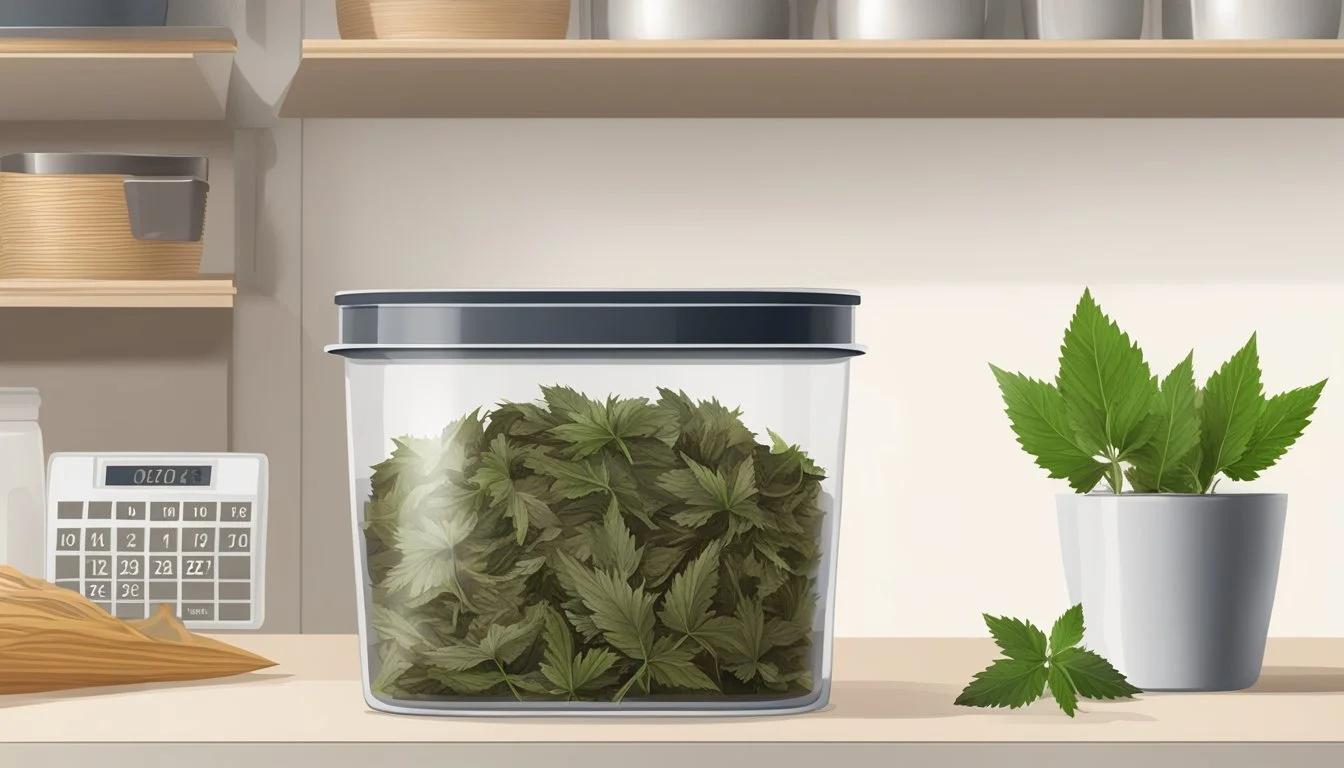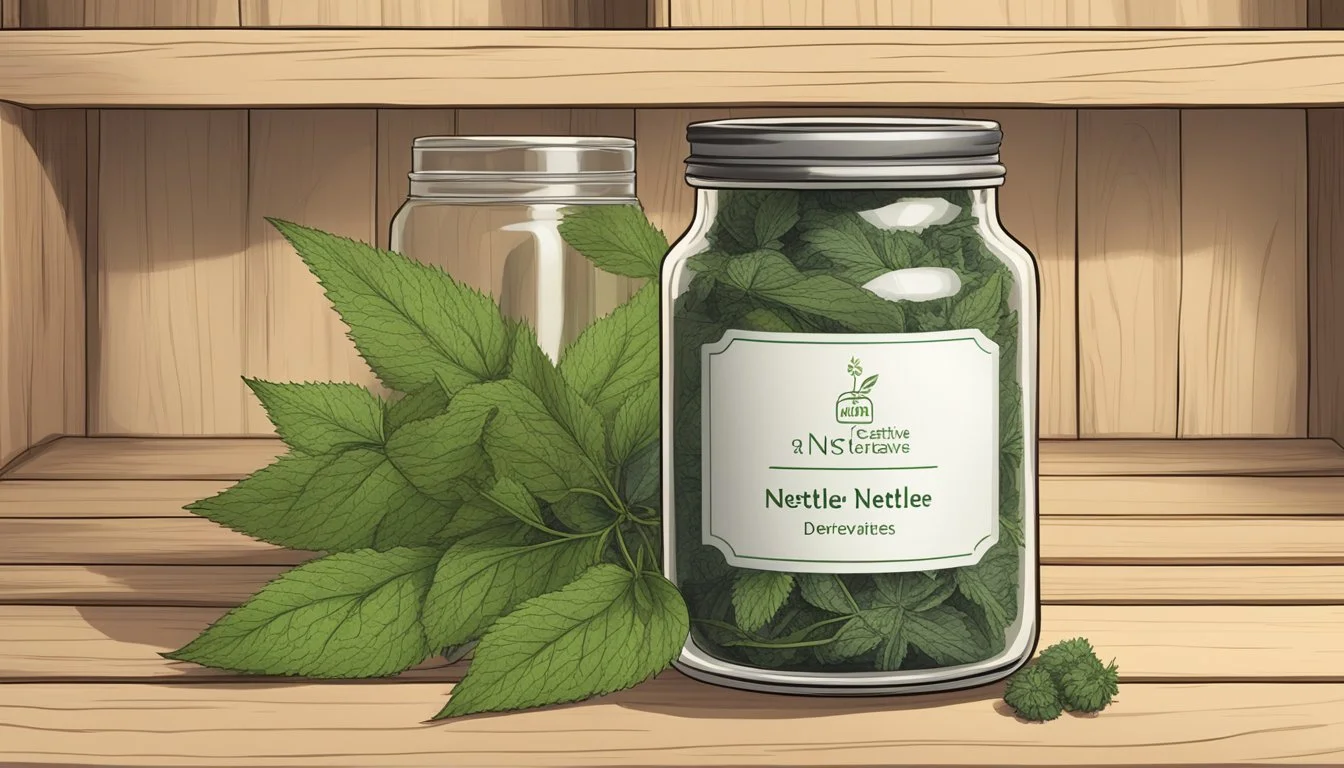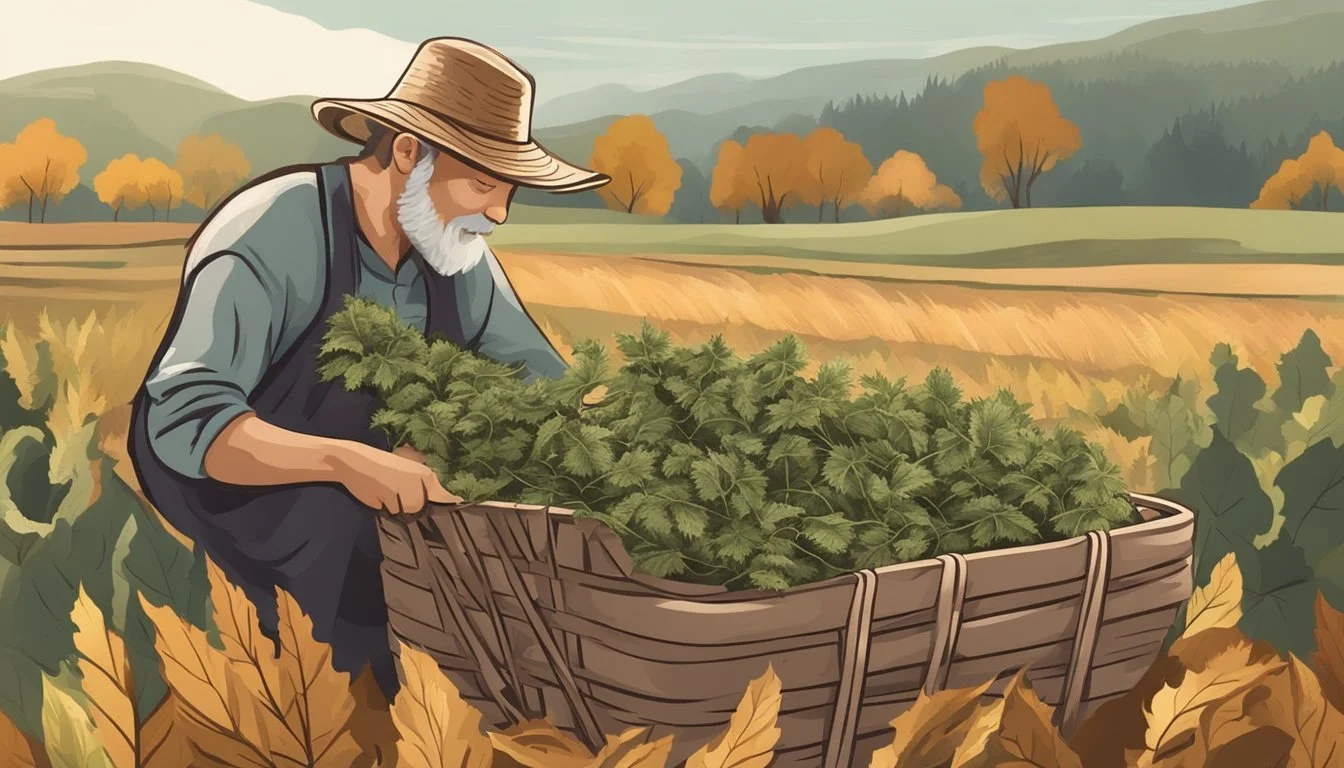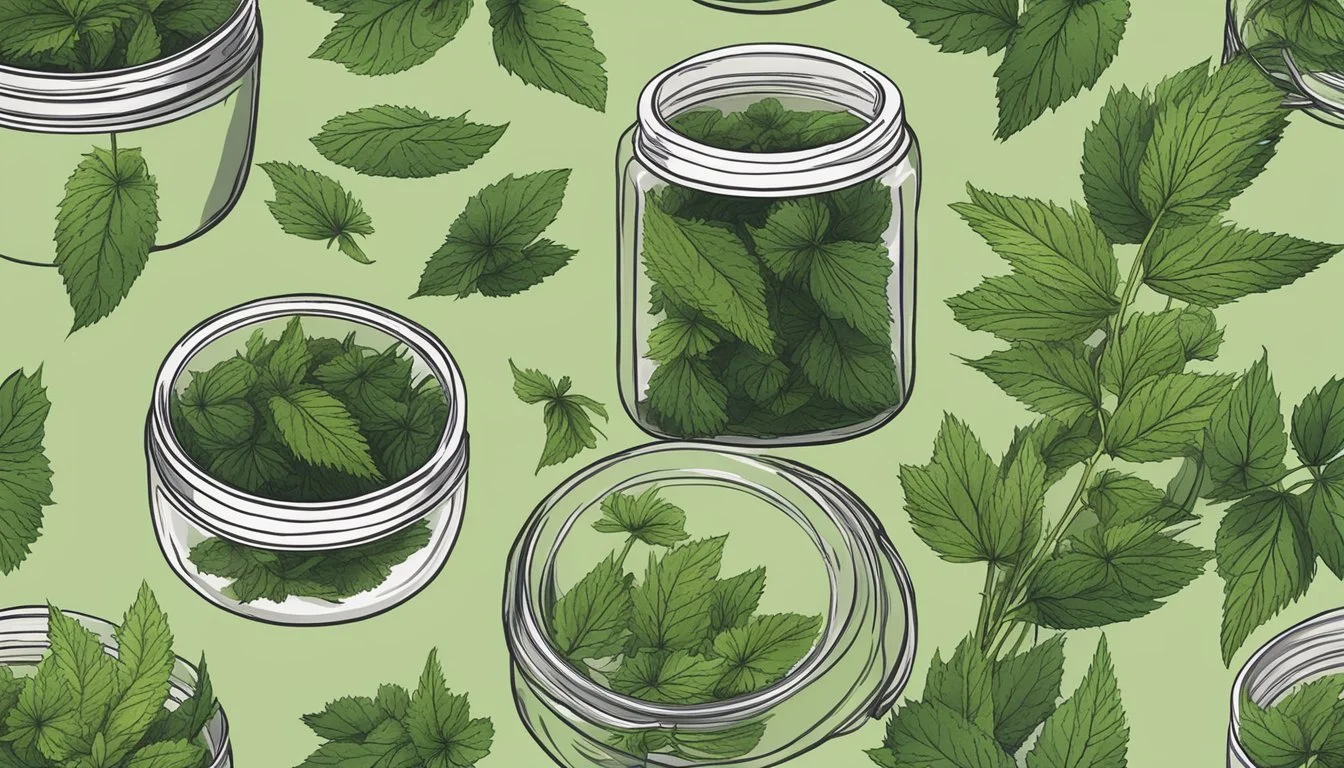How Long Do Dried Nettle Leaves Last?
Uncovering Their Shelf Life
Dried nettle leaves are a staple in herbal medicine, lauded for their various health benefits, which range from reducing inflammation to alleviating allergic reactions. As with any dried herb, the shelf life of dried nettle leaves is a point of interest for consumers who want to ensure they're getting the most out of their herbal products. Properly dried and stored, nettle leaves can retain their quality and potency for a considerable period, allowing users to enjoy the benefits of this herb throughout the year.
The longevity of dried nettle leaves hinges on the method of drying and subsequent storage practices. When dried thoroughly to the point where all moisture is removed, which typically involves a dehydrator or air-drying in a cool, dark place, nettles can last quite a while. Storing dried nettle leaves in an airtight container, away from direct sunlight and moisture, is essential for preserving their quality. Factors such as exposure to light, heat, and moisture can significantly reduce the leaves' shelf life, leading to a loss of flavor and therapeutic effectiveness.
Understanding the proper techniques for drying and storing nettles is of prime importance for those looking to maintain a home supply of the herb. It ensures that the nettles are not only safe for consumption over time but also that their beneficial compounds remain intact. Thus, it is not merely the act of drying nettles that determines their shelf life, but also how they are cared for once dried.
Nutritional Profile of Dried Nettle Leaves
Dried nettle leaves are nutrient-dense, providing a substantial concentration of vitamins and minerals along with beneficial plant compounds. Their high nutrient content positions them as a valuable inclusion in a health-conscious diet.
Vitamins and Minerals
Dried nettle leaves are particularly rich in:
Vitamins: They provide an abundance of Vitamins A, C, and K, with notable quantities of the B vitamins.
Minerals: These leaves are an excellent source of minerals including calcium, iron, magnesium, and potassium.
A specific emphasis on their iron content makes them a compelling choice for those looking to bolster their intake of this essential mineral, while a robust level of calcium contributes to bone health and neural functions.
Protein and Fiber Content
Dried nettle leaves offer more than just vitamins and minerals:
Protein: They contain a moderate amount of protein, which is essential for muscle repair and enzymatic functions in the body.
Fiber: The fiber content in nettle leaves supports digestive health and can aid in blood sugar management.
The combination of protein and fiber within these leaves not only supports metabolic processes but also contributes to a feeling of fullness, potentially aiding in weight management.
Health Benefits of Nettle Leaves
Nettle leaves, recognized for their health-promoting attributes, offer a variety of medicinal benefits. They are particularly renowned for their anti-inflammatory properties and their supportive role in various health concerns related to inflammation, blood sugar, and allergies.
Anti-Inflammatory Effects
The anti-inflammatory quality of nettle leaves plays a pivotal role in mitigating inflammation-related health issues. They contain compounds that may reduce the production of inflammatory hormones within the body, thereby easing discomfort associated with inflammatory conditions.
Support for Arthritis and Joint Pain
Studies indicate that the application of nettle leaves may alleviate joint pain and assist in managing symptoms of arthritis. This benefit is attributed to the plant's anti-inflammatory properties, which make it a beneficial natural remedy for those suffering from joint-related ailments.
Benefits for Hair and Skin
Nettle leaves are often associated with promoting healthier hair and skin. They are known to be nutritious, containing a range of vitamins and minerals that could enhance the overall health of hair follicles and potentially improve the condition of the skin, potentially impeding signs of aging.
Blood Sugar and Pressure Regulation
In relation to diabetes, nettle leaves might play a role in managing blood sugar levels. Additionally, they may contribute to the regulation of blood pressure, owing to their diuretic effect, which helps modulate bodily fluids and blood pressure.
Effects on Allergies and Hay Fever
For individuals experiencing seasonal allergies or hay fever, nettle leaves contain properties that could alleviate symptoms. They have been used historically to aid in the relief of breathing-related problems associated with such allergic reactions.
Prostate Health
Nettle leaves have been linked to beneficial effects on benign prostatic hyperplasia (BPH), which is a common condition affecting prostate health in aging men. Their role in prostate health stems from their potential to moderate symptoms related to BPH.
Preparation and Consumption Methods
Dried nettle leaves offer versatility in the kitchen, enabling a variety of preparation methods and culinary uses. They can be transformed into soothing teas, infused into dishes, and even incorporated into healthful smoothies.
Tea and Herbal Infusions
To enjoy stinging nettle in a soothing drink, one can craft a nettle tea by steeping 1 tablespoon of dried nettle leaves in 10 ounces of boiling water for approximately 10 minutes. This allows the flavors and beneficial properties to infuse into the water. For a herbal tea, individuals may choose to leave the mixture steeping for a longer period, enhancing the extraction of nutrients. After steeping, one should strain the mixture to remove the leaves.
Cooking with Nettle Leaves
Dried nettle leaves can elevate dishes with their rich, earthy flavor. They are used in recipes such as soup, pasta, and bread. When cooking with nettle leaves, one should first rehydrate them if a softer texture is desired. These leaves can be added directly to noodles or kneaded into bread dough. For soups, nettles add depth and are typically added during the simmering process.
Nettle in Smoothies and Other Recipes
For a nutrient boost, dried nettle leaves can be incorporated into smoothies. The leaves blend well with ingredients like lemon and may be ground into a fine powder before adding to the smoothie mixture to ensure an even texture. Nettle is not limited to smoothies; it can also be used in recipes where greens are typically used. This includes being mixed into a tincture or as a garnish on various dishes for added nutrition and flavor.
Proper Handling and Drying Techniques
Ensuring the longevity of dried nettle leaves starts with proper harvesting and drying methods, followed by effective storage solutions. These steps are crucial for preserving the potency and flavor of stinging nettle.
Foraging for Nettle Leaves
When sourcing stinging nettle (Urtica dioica), one should don protective attire including gloves and long sleeves to avoid the plant's irritating sting. Harvesting stinging nettle should involve selecting the top 4-6 inches of the stem where the nettle leaves are most tender. It's important to use scissors or shears for a clean cut and to ensure that the remaining plant can continue to grow.
Drying Process
The drying of nettle leaves should be carried out promptly after harvesting to prevent spoilage. The leaves can be dried effectively using a dehydrator set to the lowest setting, typically around 95°F (35°C). This process can take 12 to 18 hours. It is essential to check the stems for complete dryness, as they tend to take longer to dry than the leaves themselves.
Storage and Shelf Life
Once dry stinging nettle is prepared, it should be stored in an airtight container, away from direct sunlight, to maintain its quality. Under ideal conditions, dried nettle leaves can last up to a year or more, though checking for freshness and potency every few months is recommended.
Potential Side Effects and Precautions
While dried nettle leaves offer numerous health benefits, it's critical to be aware of their potential side effects and the necessary precautions when handling them. Understanding these risks can help ensure safe usage.
Handling and Allergic Reactions
Stinging nettles contain histamine and other irritants which can cause allergic reactions when touched. Handling dried nettle leaves may still provoke skin irritation, manifesting as a mild rash or eczema in sensitive individuals. It is advisable to use gloves when handling nettles to prevent this.
Considerations for Certain Health Conditions
Individuals with certain health conditions should exercise caution. For instance, pregnant women are generally advised to avoid nettles due to their potential to stimulate uterine contractions. Additionally, those with diabetes should monitor their blood sugar levels closely as nettles can lower blood glucose. Notably, nettles may cause side effects such as stomach discomfort when ingested. It's crucial to consult with a healthcare provider before using nettles, especially if one has underlying health issues or is on medication.
Nettle in Traditional and Global Uses
Nettle, a plant rich in vitamins and minerals, has been utilized for its health benefits in traditional and global contexts, with particular emphasis on its medicinal uses and incorporation into various cuisines.
Historical Medicinal Uses
Nettle has played a significant role in traditional medicine across Europe, Asia, and North America. It is renowned for its detoxification properties and its ability to modulate inflammatory pathways, which contemporary studies corroborate. Historically, nettle was used to treat a range of ailments from joint pain to skin conditions. In Europe, particularly, nettle has been documented by Greek physicians such as Dioscorides and Galen for its medicinal qualities, and its applications span from brewed tea to poultices.
Europe: Used as a diuretic and for treating joint pain.
Asia: Utilized mostly for its natural antihistamine properties.
North America: Traditional healers used nettle to support upper respiratory health.
Nettle in World Cuisines
Globally, nettle finds its place not only in medicinal teas but also in a variety of traditional recipes, likened to spinach (What wine goes well with spinach?) or **basil
Comparing Nettle to Other Greens
When assessing the nutritional value of nettle leaves relative to other greens such as spinach and kale, one can observe distinct differences in mineral and vitamin content.
Nettle Versus Spinach and Kale
Stinging nettle presents a robust profile of minerals and vitamins, offering significant amounts of calcium and iron. Here's how nettle stands up against spinach and kale:
Iron Content: Nettle boasts a high iron content, often surpassing that of spinach, which is traditionally celebrated for this mineral. Iron is crucial for forming hemoglobin, which carries oxygen in the blood.
Green Iron (per 100g) Nettle 1.64 mg Spinach 2.71 mg Kale 1.5 mg
Calcium: Recognized for its calcium content, nettle can hold its own against kale, which is often a go-to source for this bone-strengthening mineral.
Green Calcium (per 100g) Nettle 481 mg Spinach 99 mg Kale 150 mg
Vitamins: While all three greens contain a variety of vitamins, nettle is particularly rich in vitamin A and vitamin C, essential for immune function and vision.
Green Vitamin A (IU) Vitamin C (mg) Nettle 6,500 IU 76.0 mg Spinach 9,378 IU 28.1 mg Kale 9,990 IU 120 mg
The figures highlight that while spinach and kale are often the go-to greens for many, nettle should not be overlooked, especially considering its contribution to the iron and calcium intake.
Creative Nettle Derivatives
From enhancing the nutrient profile of pantry staples to crafting personal care items, the use of dried nettle leaves extends beyond traditional infusions. These derivatives often present a concentrated form of nettles' benefits and offer a versatile way to incorporate this herb into daily life.
Nettle Powders and Supplements
Nettle leaves can be transformed into a fine powder that is ideal for including in supplements or adding to smoothies for an extra health kick. They are dried and ground into a fine consistency, ensuring their natural qualities are preserved:
Nettle Leaf Powder: Typically used in capsules or mixed into smoothies
Supplements: Contain dried nettle in a concentrated form for ease of use and potentially higher yield of benefits
Homemade Nettle Products
Creative homemade products from nettle leaves extend to both culinary and non-edible items, showcasing the plant's versatility:
Nettle Leaf Tea: Steep dried leaves to create a soothing and nutritious tea.
Tinctures: Fresh or dried nettle leaves are soaked in alcohol, vinegar, or glycerin. The mixture is left to strain, resulting in a potent liquid for various uses.
Soaps and Skincare: Nettle's skin-friendly properties are harnessed by incorporating the dried leaves or extracts into soaps and skin formulations.
Harvest Season and Collection
In the context of harvesting nettles, timing and methodology are pivotal for yielding quality leaves while preserving the plant species for future growth.
Optimal Time for Harvesting Nettle
The ideal timeframe to harvest stinging nettle (Urtica dioica) is during spring, when the plants are young and tender. The forager should target nettles when they are between 3 to 6 feet in height and before the plants start to flower. The leaves at this stage offer the highest nutritional value. It's best to select the topmost leaves—ideally no larger than about 3 inches wide—as they are the most potent and have not yet developed gritty textures or robust fibers that older leaves possess.
Sustainable Foraging Practices
When foraging nettles, one should employ practices that ensure sustainability and prevent overharvesting, which could lead to depletion of local nettle populations. Suggested measures include:
Rotational harvesting: Refrain from clearing all the nettles in a single area; instead, forage selectively to allow the plants to recover.
Equipment use: Utilize gloves and scissors to cleanly snip the leaves, which helps to preserve the integrity of the plant and reduce damage that could inhibit regrowth.
Environmental consideration: Leave behind the roots and a significant portion of the stem to promote regeneration, and ensure not to damage surrounding flora.
Harvesting before seeding: Collecting nettles before they produce seeds ensures that they remain in prime condition for consumption and that the plant can continue its lifecycle uninterrupted.
In following these guidelines, foragers will successfully gather nettle leaf for drying, while contributing to the perennial health of the stinging nettle population.
Incorporating Nettle Into Diets
Nettle leaves, known for their nutritious profile, are a versatile ingredient suitable for a range of diets and can support detoxification efforts. They offer health benefits due to their high content of fiber, protein, and minerals, with low levels of fats and sugars.
Nettle for Special Diets and Detoxification
Nettle is accommodating to various special diets, providing a source of plant-based protein and fiber while being low in fat and sugar. For vegans and vegetarians, the protein content in nettle makes it a valuable addition to their diet. Those on a gluten-free diet can also incorporate nettle into their meals without concern, as it is naturally gluten-free.
In detox diets, nettle's role is notable for its diuretic properties, which support the body's natural detoxification processes. It can aid in eliminating toxins and promoting kidney health.
Recipe suggestions:
Nettle tea: Steep dried nettle leaves in hot water for a simple herbal tea.
Salads: Use a salad spinner to ensure fresh nettle leaves are clean and dry, then toss them into salads for a nutritious boost.
By incorporating nettle into their diets, individuals can enjoy not only the detoxification properties but also the nutritional advantages it offers.
Frequently Asked Questions
In this section, readers will find precise and valuable information addressing common inquires on the use and storage of dried nettle leaves.
Common Queries About Nettle Use and Storage
How long do dried nettle leaves last?
When stored properly, dried nettle leaves can have a shelf life of 6-12 months. Beyond this period, while they may still be safe to consume, the quality and potency may degrade.
What is the best way to store dried nettle leaves?
Dried nettle leaves should be kept in an airtight container, away from direct sunlight and moisture, to preserve their quality and extend their shelf life.
Can dried nettle leaves still sting?
Once nettle leaves are dried correctly, they lose their ability to sting. The process of drying effectively neutralizes the stinging compounds.
Are there specific instructions for drying nettle leaves?
To dry nettle leaves, spread them in a single layer on a drying rack or hang them in bunches in a well-ventilated, dry space away from direct sunlight. Allow drying for 12-18 hours or until crispy.
What is the nutritional value of dried nettle leaves?
Dried nettle leaves are rich in vitamins and minerals, retaining most of the nutritional value of fresh nettles, making them beneficial for various health purposes.
Final Thoughts
When storing dried nettle leaves, one’s main focus should be on maintaining their potency and flavor for as long as possible. Properly dried and stored nettle leaves can last up to a year without significant degradation of quality. To ensure maximum longevity, they should be kept in a cool, dry place away from direct sunlight and moisture. Airtight containers are ideal in preserving the leaves' integrity.
It is essential to check for signs of spoilage, such as mold or a musty smell, as these indicate that the leaves are no longer suitable for consumption. One may also notice a decline in the potency of flavor or aroma that suggests the leaves are past their prime.
Here's a quick checklist for optimal storage:
Keep dry: Ensure the leaves are completely dehydrated before storing.
Use airtight containers: Seal the leaves away from air exposure.
Avoid light and heat: Store in a cool, dark place.
Label clearly: Mark containers with the date of drying.
In summary, diligent storage practices enable the prolonged use of dried nettle leaves, securing their benefits and culinary uses for extended periods.














